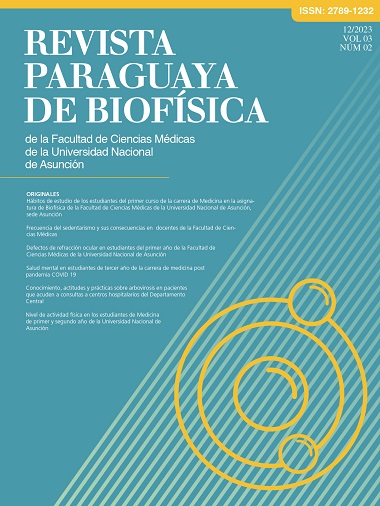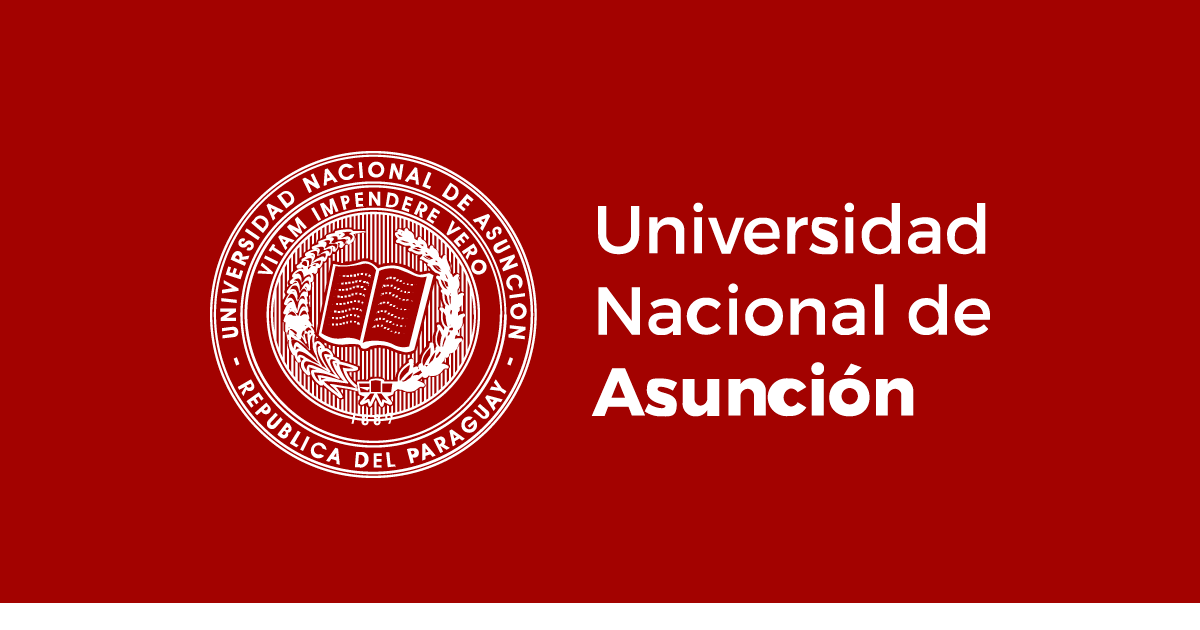Nivel de actividad física en los estudiantes de Medicina de primer y segundo año de la Universidad Nacional de Asunción
Keywords:
physical activity, students, healthAbstract
Introduction: Medical students face an intense academic load and high levels of stress due to the demands of their career. This often leads them to prioritize studying over physical activity. The physical and mental exhaustion they experience can make it difficult for them to find the energy and motivation to exercise. Additionally, time constraints, due to changing schedules and the need to prepare for exams, make it difficult for them to participate in physical activity on a regular basis.
Therefore, this research aimed to determine the percentage of first and second year students of the Faculty of Medical Sciences of the National University of Asunción who do or do not practice physical activity, as well as the perceived benefits and barriers they experience in doing so.
Materials and methods: Cross-sectional, descriptive and observational study, with a quantitative approach, carried out at the Faculty of Medical Sciences of the National University of Asunción. A digital survey via Google Forms was used to collect data, which were loaded into a database in Excel format for subsequent analysis.
The data collected was used anonymously, voluntarily and exclusively for the purposes of this research.
Results: 179 first and second year UNA medical students were surveyed, 114 females. The majority of respondents were between the ages of 18 and 21. 62% of those surveyed said they engaged in regular physical activity and 38% did not. Differences were observed in terms of the frequency of physical activity; However, there was a predominance in terms of the type of physical activity performed: weight lifting (57.7%). Regarding the benefits that physical activity provides, the control of body weight stood out (81.1%). Regarding the reason why there are students who do not do physical activity, a predominance (82.4%) was seen due to lack of time. It was also observed that all students agree that performing physical activity regularly can provide them with important benefits.
Conclusion: The majority of the medical students of first and second year from the Universidad Nacional de Asuncion, engage in physical activity regularly, experiencing benefits such as stress reduction and improvements in their focus. Regarding students who don't engage in physical activity, the main obstacle they face is lack of time because of the academic demand
Both f+groups of students are aware of the importance and benefits of engaging in physical activity.
Downloads
References
(1) Organización Mundial de la Salud [Internet]. [citado 6 de noviembre de 2023]. Actividad física. Disponible en: https://www.who.int/es/news-room/fact-sheets/detail/physical-activity
(2) School EB. Euroinnova Business School. [citado 5 de noviembre de 2023]. ¿Cuantos tipos de actividades fisicas existen? | Euroinnova. Disponible en: https://www.euroinnova.com.py/cuantos-tipos-de-actividades-fisicas-existen
(3) Hombros25. La importancia de la actividad física en nuestra salud [Internet]. Wunder Training. 2020 [citado 5 de noviembre de 2023]. Disponible en: https://www.wundertraining.com/la-importancia-de-la-actividad-fisica-en-nuestra-s alud/
(4) Ramírez Prieto MB, Raya Franco M, Ruiz del Rio M. Sedentarismo y salud: efectos beneficiosos de la actividad física en estudiantes universitarios. Sedentary Lifestyle and Health: BeneficialEeffects of Physical Activity in University Students [Internet]. 2018 [citado 6 de noviembre de 2023]; Disponible en: https://digibug.ugr.es/handle/10481/49826
(5) Redacción DS. Beneficios de la Actividad Física en Estudiantes de Medicina [Internet]. DiarioSalud.do. 2019 [citado 5 de noviembre de 2023]. Disponible en: https://www.diariosalud.do/estudiantil/beneficios-de-la-actividad-fisica-en-estudiant es-de-medicina/
(6) Contreras Fernández JJ, Espinoza Aravena RM, Dighero Eberhard B, Drullinsky Alvo D, Liendo Verdugo R, Soza Rex F. Actitud sedentaria y factores asociados en estudiantes de Medicina. Rev Andal Med Deporte. 1 de diciembre de 2009;2(4):133-40.
(7) Stanford FC, Durkin MW, Blair SN, Powell CK, Poston MB, Stallworth JR. Determining levels of physical activity in attending physicians, resident and fellow physicians and medical students in the USA. Br J Sports Med. 1 de abril de 2012;46(5):360-4.
(8) Duperly J, Lobelo F, Segura C, Sarmiento F, Herrera D, Sarmiento OL, et al. The association between Colombian medical students’ healthy personal habits and a positive attitude toward preventive counseling: cross-sectional analyses. BMC Public Health. 3 de julio de 2009;9(1):218.
(9) Cantero RBB, Galeano FMB, Soria JAB, Venialgo JCB, Desvar TKB, Maldonado GB, et al. Frecuencia de sedentarismo en estudiantes de medicina de primer año. Rev Paraguaya Biofísica. 30 de junio de 2021;1(1):25-8.
(10) Santillán Obregón RR, Asqui Luna JE, Casanova Zamora TA, Santillán Altamirano HR, Amparo Obregón G, Vásquez Cáceres MG. Nivel de actividad física en estudiantes de administración de empresas y medicina de la ESPOCH. Rev Cuba Investig Bioméd. diciembre de 2018;37(4):0-0.
(11) Sterling Londoño G, Quiñones E, Ramírez-Vélez R. Condición física, actividad física y dificultades para su realización en estudiantes de medicina. Rev Médicas UIS. 1 de enero de 2011;24:15-22.
(12) Bolaños Vergaray JJ, Zegarra Piérola JW. Los futuros médicos y la actividad física: una contradicción no saludable. Apunts Sports Med. 1 de julio de 2010;45(167):151-9.
(13) Jáuregui E, Ibañez A, Ascanio-Sandoval C, Copado Aguila S. Guía de Promoción y Consejería de la Actividad Física. 2022.
(14) Martínez LNI, Dechapelle MH, Fundora OLU. Barreras para la práctica de actividades físicas en estudiantes de la Escuela Latinoamericana de Medicina. Panor Cuba Salud. 22 de marzo de 2017;12(1 Esp):6-8.
(15) Vries JD de, Hooff MLM van, Geurts SAE, Kompier MAJ. Exercise as an
Intervention to Reduce Study-Related Fatigue among University Students: A Two-Arm Parallel Randomized Controlled Trial. PLOS ONE. 31 de marzo de 2016;11(3):e0152137.
(16) Leuchter RK, Stuber ML, McDonald AL, Croymans DM. Relationship between exercise intensity and stress levels among U.S. medical students. Med Educ Online. 31 de diciembre de 2022;27(1):2027651.
(17 ) Lee K, Bae H, Jang S. Effect of Exercise Combined with Natural Stimulation on Korean College Students’ Concentration and Positive Psychological Capital: A Pilot Study. Healthcare. abril de 2022;10(4):673.
(18) Ruegsegger GN, Booth FW. Health Benefits of Exercise. Cold Spring Harb Perspect Med. 7 de enero de 2018;8(7):a029694.
(19) Haverkamp BF, Wiersma R, Vertessen K, van Ewijk H, Oosterlaan J, Hartman E. Effects of physical activity interventions on cognitive outcomes and academic performance in adolescents and young adults: A meta-analysis. J Sports Sci. 1 de diciembre de 2020;38(23):2637-60.
Downloads
Published
How to Cite
Issue
Section
License
Copyright (c) 2024 Elias Emmanuel Mendez Gonzalez, Maria Sol Mendieta Gimenez, Rafael Josue Mereles, Tito Ariel Mereles Algarin, Tobias Martin Meza Sosa, Rebeca Maria Denice Nuñez Fleitas, Linda Patricia Nuñez Gonzalez, Paola Nuñez Tutunyi, Olivia Ocampos Arenas, Gabriela Marylin Olmedo Ortiz, Cecilia Eliane Ortiz Ruiz Diaz, Belinda Figueredo

This work is licensed under a Creative Commons Attribution 4.0 International License.





